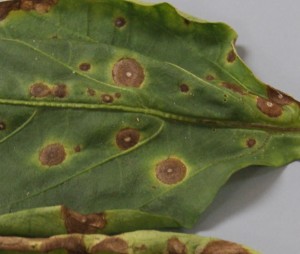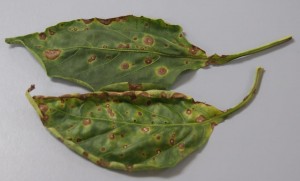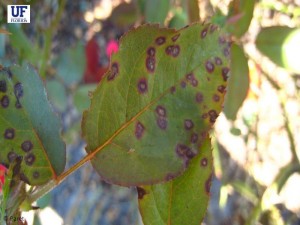This summer’s rainy and humid weather has created a perfect environment for the proliferation of a variety of fungal diseases. In particular, Cercospora is a genus of fungus of which there are over 1,200 different species. Because there are so many species of this fungus, many different plant species are affected including many garden vegetables and ornamentals.
Cercospora causes purple, brown or black spots on a variety of garden vegetables and ornamental shrubs. The spots usually include a grey dead area in the center and a yellow “halo” or “ring” surrounding the entire spot. This disease usually starts at the base and interior of the plant, where there is more moisture and less air circulation, and moves outward.
Severe Cercospora infections have the ability to defoliate entire plants within a season and kill garden annuals, such as pepper, within a season. On shrubs, turf and perennials, Cercospora ranges from minor annoyance to major disease depending on the resistance of the cultivar or species. Serious infections can kill some ornamentals, such as Indian Hawthorn or Rose, in three years.
Several methods exist to limit the spread and severity of Cercospora outbreaks. It is a good practice to remove all dead plants and leaf litter from the garden. If Cercosproa infection occurs, remove and dispose of dead plants and pick up all leaf litter from the garden immediately upon drop. This will limit the fungal spore’s ability to reproduce. Another preventative strategy is to reduce water splash on leaves. Splashing water spreads Cercospora spores and allows them to take hold on a leaf. Irrigate the vegetable garden or landscape with drip irrigation to avoid wet leaves. Additionally, irrigate in the morning, so plants will not remain wet overnight. Cercospora requires 16 hours of moisture to reproduce. Specifically, infection of Indian Hawthorn has proven to be reduced by switching from overhead to drip irrigation.
If fungicides must be used, be sure to follow label directions since some products labeled for the home ornamental garden, such as Chlorothalonil, are not labeled for turf. Be sure to use fungicides with more than one mode of action, since resistance may develop if only one type of fungicide is used.
For more information, please consult the following UF / IFAS publications regarding Cercospora:
Also, contact your County Extension Office for additional assistance.
- Woodland Pinkroot Adds Vibrant Color to Spring Landscapes - April 27, 2023
- Easy Care Roses for the Gulf South - April 20, 2023
- Herb Gardening: When Oregano is Flavorless - March 9, 2023



